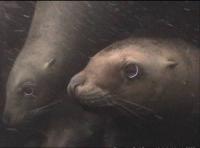Fasting and Foraging ability

Fasting-induced physiological changes include a reduction in metabolic rate. While fasting, subcutaneous fat is used as a nutritional resource and the extent of metabolic suppression determines how long these resources will last. Most pinnipeds experience natural periods of fasting and respond to these periods by metabolic depression. In most vertebrates, fasting induced hypometabolism is the result of down regulation of body functions such as protein synthesis, thermoregulation and digestion to limit tissue catabolism. Consequently, for a marine mammal a fasting-induced hypometabolism may increase aerobic dive duration. Reduced insulative fat stores, on then other hand, may significantly increase heat loss possibly resulting in an increased metabolic rate and reduced aerobic dive duration.
Understanding how periods of natural or unpredicted periods of fasting affect the metabolic cost of foraging is an essential part in solving the energy budget of wild Steller sea lions. It provides important information on how alterations and unpredictable changes in prey abundance may affect the foraging strategies of Steller sea lions
Responsible for this page:
Director of undergraduate studies Biology
Last updated:
05/26/08
